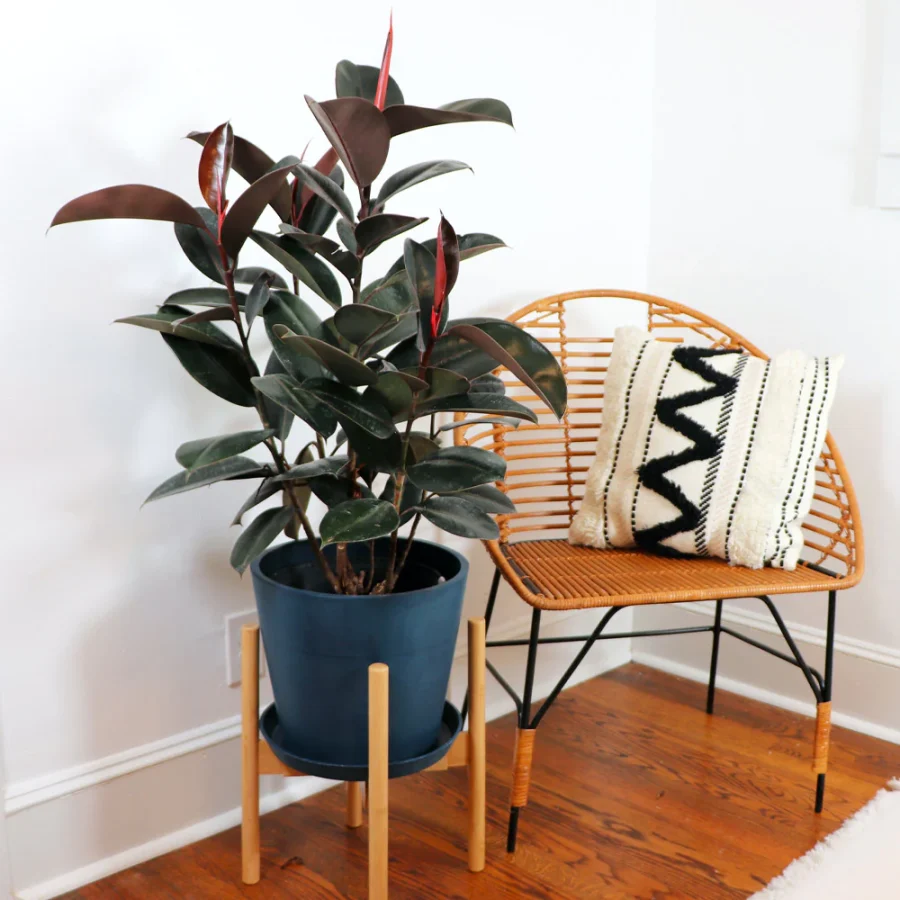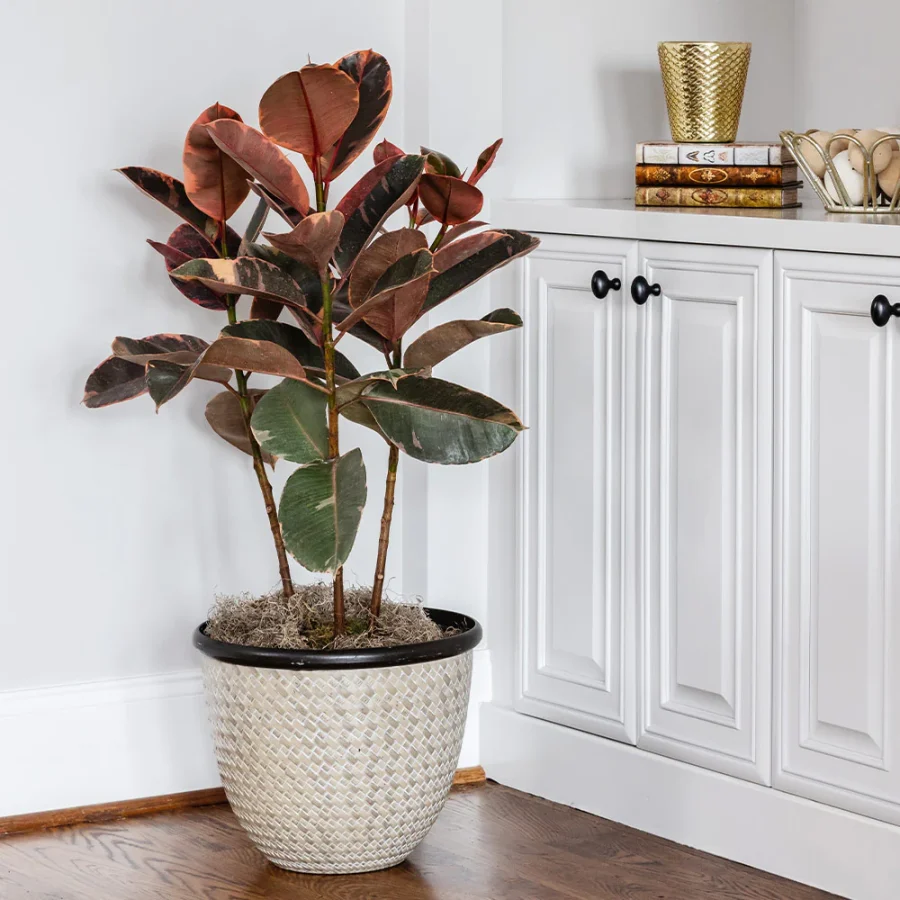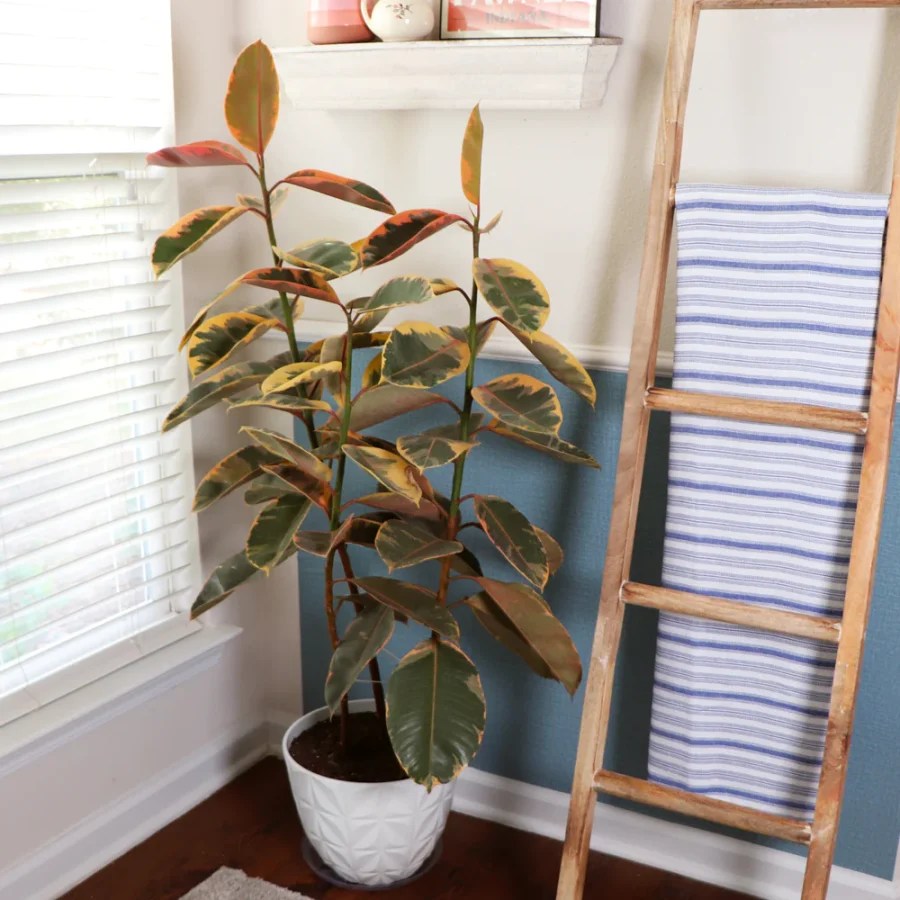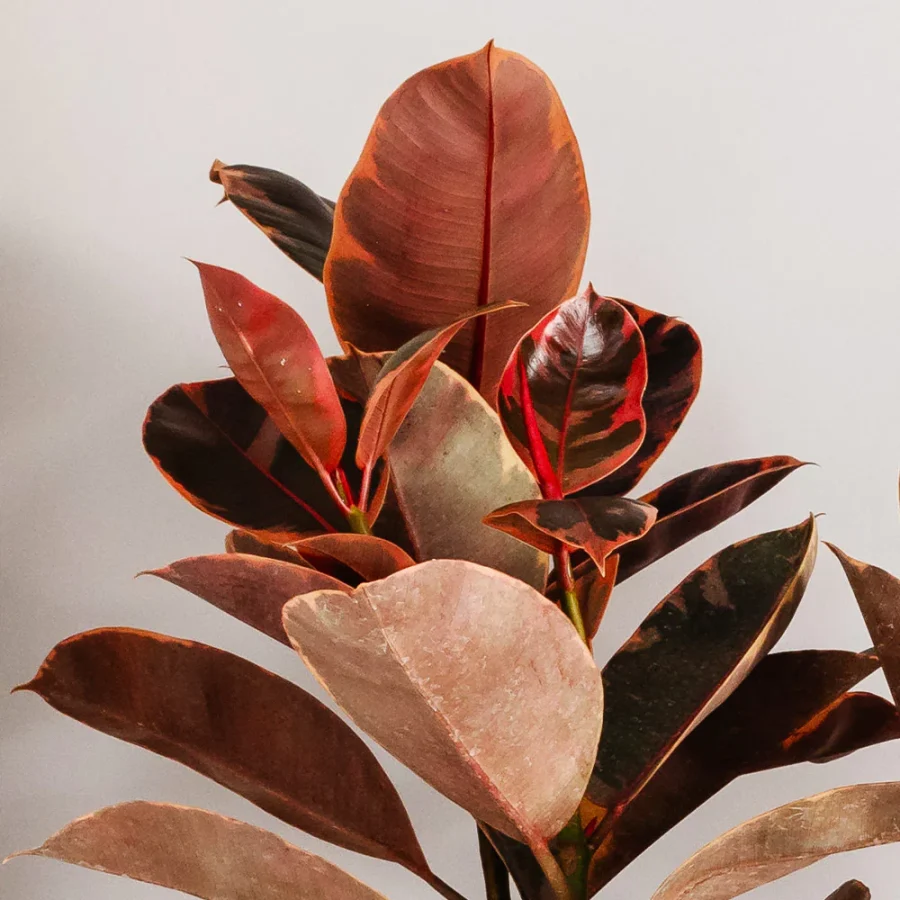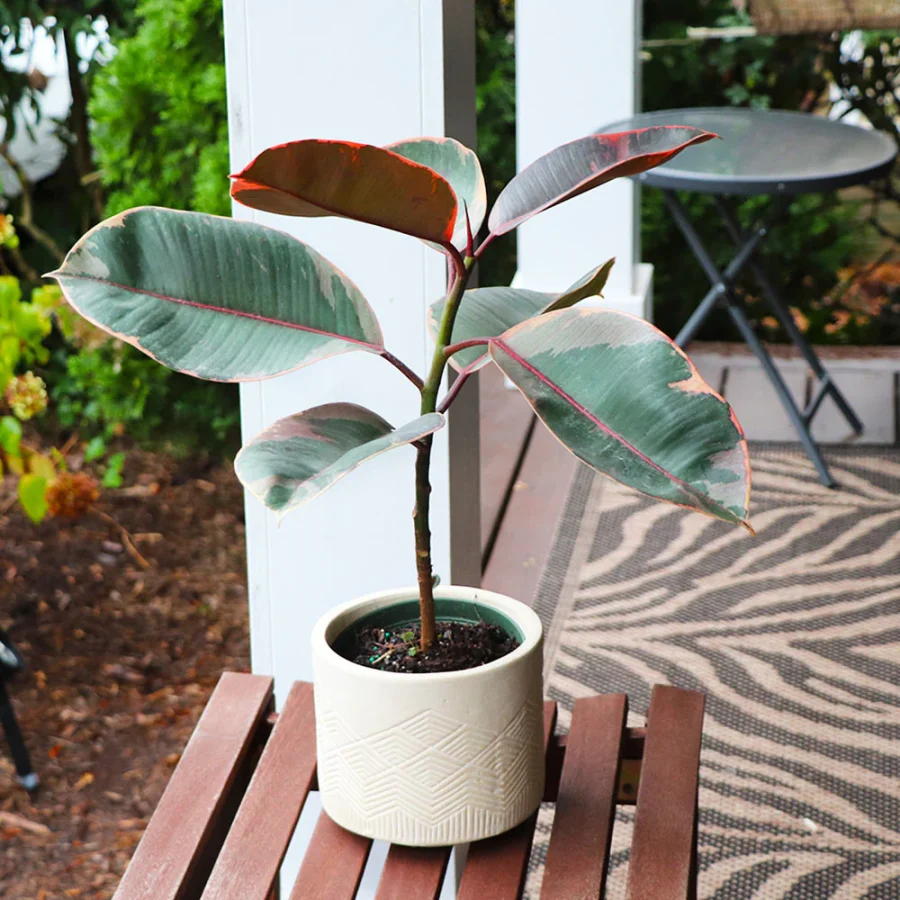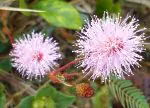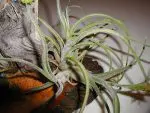This post contains affiliate links. If you buy something from one of our links we may earn a commission. Thanks
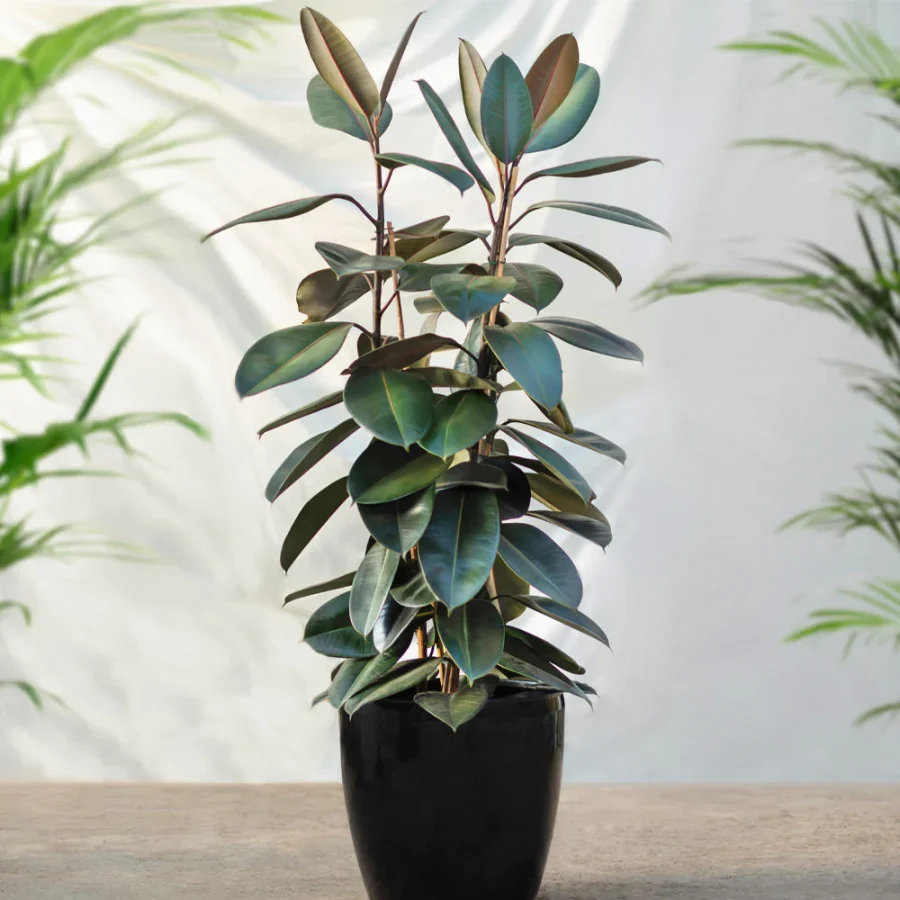
Discover the joy of rubber plant care indoors! Our ultimate guide covers everything you need to know for a thriving, happy plant in your home. Join us!
Rubber Plant care indoors involves placing the plant in bright, indirect light and watering it when the top inch of soil is dry. A well-draining soil mix is recommended. Keep the plant away from direct sunlight to avoid leaf burn and maintain temperatures between 60-75°F for optimal growth.
Welcome to the world of rubber plant care indoors! As one of the most popular and versatile houseplants, the rubber plant can bring a touch of the tropics into your living space.
But how do you ensure that your green companion thrives and flourishes?
Our ultimate guide will walk you through everything you need to know about caring for your rubber plant.
From lighting to watering, we’ve got your back, so let’s dive in and get those green thumbs working!
Rubber Plant Care Indoors: The Ultimate Guide to a Thriving Rubber Tree
Hey there, fellow plant lovers! Are you ready to explore the exciting world of rubber plant care indoors?
These stunning, low-maintenance houseplants can elevate any living space with their lush foliage and tropical vibes.
In this comprehensive guide, we’ll delve into all aspects of rubber tree plant care, ensuring that your leafy friend thrives and grows to its full potential.
Whether you’re a seasoned plant expert or just starting your indoor jungle journey, we’ve got the tips and tricks you need.
So, let’s get started and transform your home into a vibrant, green oasis!
Rubber plants have gained immense popularity as indoor plants, thanks to their striking appearance and easygoing nature.
These tropical beauties boast large, glossy leaves and can adapt well to various indoor conditions, making them the perfect addition to any home or office.
These tropical plants are native to Southeast Asia. Their natural habitat is tropical forests between India and Indonesia.
In this comprehensive blog post, we’ll cover everything from the benefits of rubber plants, their specific care needs, and even how to propagate them.
Whether you’re a proud owner of a burgundy rubber plant or just considering adding one to your indoor garden, we have all the information you need to ensure your rubber plant thrives.
So, let’s dive into the fascinating world of rubber plant care indoors and get ready to cultivate a thriving, verdant space!
Is Rubber Plant an Indoor Plant?
Are you wondering if rubber plants make good indoor companions?
Rubber plants are not only stunning to look at but also perfect for creating that cozy, inviting atmosphere in your home.
These adaptable plants are known for their resilience and ability to thrive in various indoor settings.
In this section, we’ll dive into the reasons why rubber plants are such beloved indoor plants and offer some insights into their unique features.
So, let’s get started and discover how indoor rubber trees can transform your indoor space into a lush, vibrant haven!
Perfect Indoor Companions: Rubber Plant Suitability
Rubber plants are truly exceptional when it comes to their suitability for indoor environments.
They possess a natural ability to adapt to various conditions, making them ideal for both seasoned plant enthusiasts and beginners alike.
Their large, glossy leaves add a touch of elegance and tropical flair to any room, creating a cozy, inviting atmosphere that’s hard to resist.
Burgundy Bush, the Rubber Plant Ficus elastic
Buy Your Burgundy Rubber Plant Here
| Mature Height: | 7-8 ft. |
| Mature Width: | 2-3 ft. |
| Sunlight: | Indirect Light |
| Growth Rate: | Moderate |
| Botanical Name: | Ficus elastic |
| Does Not Ship To: | AZ,OR |
| Grows Well In Zones: | Indoors |
 The Burgundy Bush, also known as Ficus elastic the Rubber Plant, is an eye-catching, ornamental Ficus that is impossible to overlook.
The Burgundy Bush, also known as Ficus elastic the Rubber Plant, is an eye-catching, ornamental Ficus that is impossible to overlook.
Its presence brightens up any room, whether as a centerpiece or a charming 1 to 2-foot-tall table plant. When allowed to grow up to 3 feet, it becomes an inviting addition to an entryway.
What sets the Rubber Plant apart is its extraordinary and striking foliage. This Burgundy gem boasts large, 4-inch wide leaves that can grow up to 12 inches in length.
The most remarkable feature of its leaves is the deep burgundy, chocolate shades, and vivid red midrib that bring a warm, inviting touch to any living space.
Buy Your Burgundy Rubber Plant Here
Ficus Ruby (Variegated Rubber Plant) Ficus elastic ‘Ruby’
| Mature Height: | 7-8 ft. |
| Mature Width: | 2-3 ft. |
| Sunlight: | Indirect Light |
| Growth Rate: | Moderate |
| Botanical Name: | Ficus elastic ‘Ruby’ |
| Does Not Ship To: | AZ,OR |
| Grows Well In Zones: | Indoors |
Are you searching for a distinctive, low-maintenance houseplant that will make a statement amidst a sea of green? Look no further than the Ficus Ruby.
Often referred to as the Variegated Rubber Plant, Ficus Ruby has gained immense popularity as a favored houseplant.
This simple-to-grow gem showcases shiny green leaves adorned with streaks of creamy white and subtle light pink variegation.
The new growth bursts forth in a vivid ruby shade, accentuated by a striking magenta midrib.
Much like its Rubber Plant relatives, the Ficus Ruby is incredibly low-maintenance. It flourishes in low-light settings and can even withstand neglect.
Position it anywhere in your home like on a table, or even as a floor plant and watch it exhibit vigorous, robust growth.
You Can Buy your Ruby Ficus Here
Adapting to Your Space: Rubber Plant Adaptability
One of the reasons rubber plants are so cherished as indoor plants is their adaptability.
They can tolerate a range of light levels, from bright indirect light to lower light conditions.
Plus, these plants aren’t overly fussy about humidity levels, making them a great choice for homes and offices with fluctuating environments.
As long as you provide them with some basic care, rubber plants will reward you with lush, vibrant foliage.
Versatility in Style: Rubber Plant Versatility
Rubber plants are versatile not only in their care requirements but also in the way they can be styled within your space.
With their upright growth habit and striking leaves, they can serve as a stunning focal point or complementary addition to your other indoor plants.
Additionally, rubber plants come in different varieties, such as the eye-catching burgundy rubber plant, allowing you to choose the one that best fits your personal aesthetic.
This versatility makes them a fantastic option for any indoor plant collection.
How to Care for a Rubber Tree
So, you’ve brought home a beautiful rubber tree and now you’re wondering how to help it flourish. Don’t worry, we’ve got you covered!
Rubber trees are relatively low-maintenance, making them a delightful addition to your indoor garden.
In this section, we’ll break down the essentials of rubber tree care, from lighting to watering, and everything in between.
With our guidance, you’ll soon be on your way to nurturing a thriving, happy rubber tree that will brighten up your living space for years to come.
Let’s dive in and unlock the secrets to keeping your rubber tree in tip-top shape!
The Basics: General Care Requirements for Rubber Trees
Before diving into the nitty-gritty of rubber tree care, it’s essential to understand the plant’s general needs.
Rubber trees appreciate a well-lit space with bright, indirect light, well-draining soil, and a consistent watering schedule.
Additionally, they’ll thrive in moderate humidity levels and benefit from occasional pruning and fertilizing.
By meeting these basic needs, you’ll set the foundation for a healthy and vibrant rubber tree.
Lighting the Way: Rubber Tree Light Requirements
One of the crucial aspects of rubber tree care is ensuring your plant receives adequate light.
Rubber trees thrive in bright, indirect sunlight, which helps them maintain their lush foliage and steady growth.
In the following section, we’ll delve deeper into the rubber tree’s light requirements and offer tips on adjusting the lighting conditions in your home to suit your plant’s needs.
Feeding and Watering: Rubber Tree Nutrition and Hydration
Another vital aspect of rubber tree care is providing your plant with the proper nutrients and hydration.
This involves using the right type of soil, knowing when and how to water your plant, and understanding the importance of fertilizing.
In the subsequent sections, we’ll explore these topics in detail, equipping you with the knowledge needed to keep your rubber tree well-fed and hydrated.
Rubber Plant Indoor Benefits
Did you know that having a rubber plant indoors comes with a range of fantastic benefits? It’s true!
Aside from their stunning appearance, rubber plants can positively impact your home’s atmosphere and even your well-being.
In this section, we’ll explore the various advantages of having a rubber plant indoors, from air purification to mood enhancement.
So, get ready to be amazed by the incredible perks of adding a rubber plant to your indoor garden, and let’s dive into the wonderful world of rubber plant indoor benefits!
Breathe Easy: Air-Purifying Properties of Rubber Plants
One of the most remarkable benefits of having a rubber plant indoors is its ability to purify the air.
These plants are known to remove harmful pollutants like formaldehyde, benzene, and ammonia from the air, helping create a healthier living environment.
By absorbing these toxins through their leaves and roots, rubber plants contribute to cleaner air, which can potentially reduce allergy symptoms and improve overall well-being.
Aesthetic Appeal: Rubber Plants as Decorative Elements
Rubber plants are not just great air purifiers; they also add a touch of natural beauty to your indoor space.
With their large, glossy leaves and striking appearance, they can effortlessly elevate the aesthetics of any room.
Whether placed in a corner, on a shelf, or as a centerpiece, a rubber plant can seamlessly blend with various design styles and instantly bring a refreshing, vibrant vibe to your home.
Boosting Your Mood: The Positive Effects of Rubber Plants
There’s something undeniably uplifting about having a rubber plant in your living space.
Studies have shown that being surrounded by plants can have a positive impact on mood, reduce stress, and even boost productivity.
By caring for your rubber plant and watching it grow, you can enjoy a sense of accomplishment and well-being, making it not just a visually appealing addition to your home, but also a fantastic mood-enhancer.
Burgundy Rubber Plant
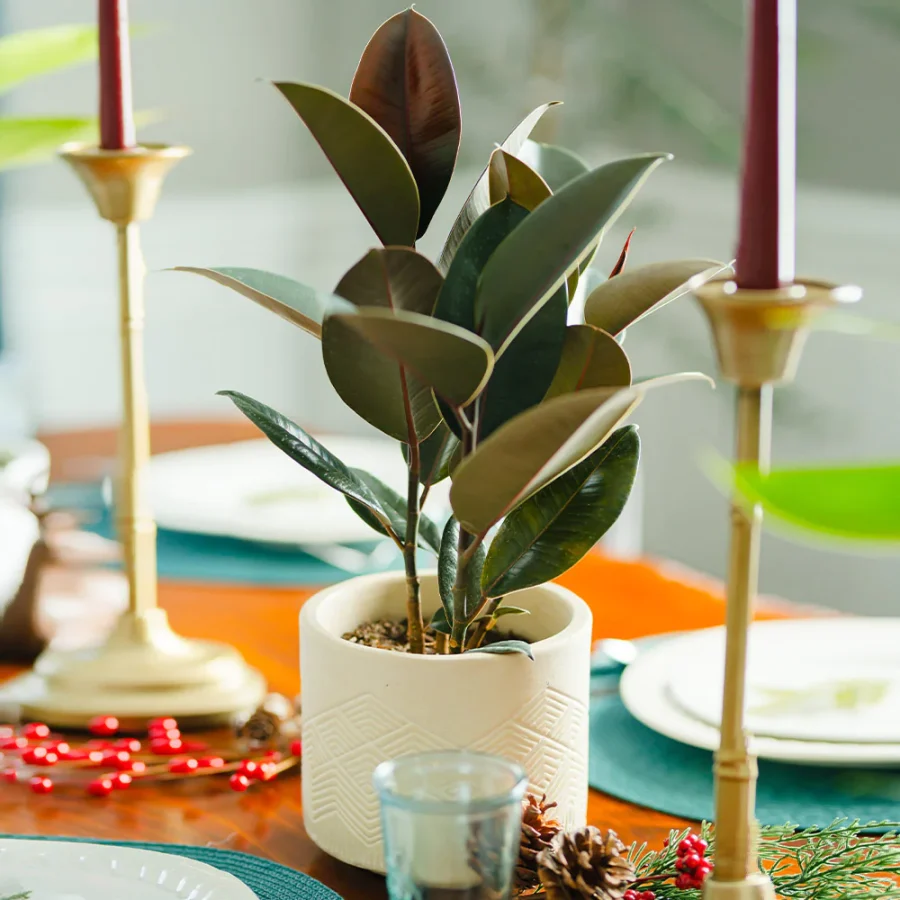
Are you ready to meet one of the most striking and sought-after members of the rubber plant family?
Say hello to the Burgundy Rubber Plant! With its captivating dark red foliage, this variety is a true showstopper, adding a touch of drama and elegance to any indoor space.
In this section, we’ll introduce you to this stunning rubber plant variety and share tips on how to care for it, ensuring that your Burgundy Rubber Plant thrives and continues to turn heads.
So, let’s get acquainted with this beautiful and mesmerizing houseplant that’s sure to steal the spotlight in your indoor garden!
Meet the Star: Introducing the Burgundy Rubber Plant
The Burgundy Rubber Plant, also known as Ficus elastica ‘Burgundy’, is a popular variety of the rubber plant family that has captured the hearts of plant enthusiasts worldwide.
With its dramatic dark red, almost purple leaves and robust growth, the Burgundy Rubber Plant makes a stunning statement in any indoor space, bringing a sense of depth and luxury to your plant collection.
Standout Features: Unique Characteristics of the Burgundy Rubber Plant
What sets the Burgundy Rubber Plant apart from other rubber plant varieties are its unique, eye-catching features.
The most striking characteristic is its rich, dark burgundy foliage that contrasts beautifully with its lighter green counterparts.
The leaves are not only large and glossy but also possess a subtle, velvety texture, further adding to the plant’s visual appeal.
Tailored Care: Burgundy Rubber Plant Care Requirements
When it comes to care requirements, the Burgundy Rubber Plant is quite similar to other rubber plant varieties.
It thrives in bright, indirect light and requires well-draining soil and a consistent watering schedule.
However, the Burgundy Rubber Plant may need a bit more sunlight to maintain its vibrant color, so it’s essential to ensure it receives adequate light exposure.
In the following sections, we’ll delve deeper into the specific care needs of rubber plants, which will also apply to the Burgundy Rubber Plant, so you can enjoy a healthy, thriving specimen in your home.
Rubber Tree Light Requirements
When it comes to keeping your rubber tree happy and healthy, providing the right amount of light is key.
But how much light does a rubber tree really need? In this section, we’ll dive into the specifics of rubber tree light requirements and help you understand how to create the perfect lighting conditions for your leafy friend.
With our guidance, you’ll be well-equipped to ensure your rubber tree receives the ideal amount of light, encouraging lush foliage and steady growth.
So, let’s shine a light on this crucial aspect of rubber tree care and set your plant up for success!
Illuminating the Importance: Proper Lighting for Rubber Plants
Proper lighting plays a significant role in the overall health and well-being of rubber plants.
Ensuring your plant receives the right amount of light is crucial for its growth, foliage development, and maintaining its vibrant color.
Inadequate lighting can lead to issues such as leggy growth, pale leaves, and even leaf drop.
That’s why understanding your rubber plant’s light requirements is essential to keep it thriving and looking its best.
The Sweet Spot: Ideal Light Conditions for Rubber Plants
Rubber plants prefer bright, indirect light to support their growth and maintain their lush foliage.
A spot near an east or west-facing window, where the plant receives dappled sunlight throughout the day, is ideal.
However, although rubber plants prefer bright light it’s important to avoid direct sunlight, as it can scorch the leaves and cause damage.
If your rubber plant is placed in a south-facing window, make sure to filter the light with sheer curtains or move it slightly away from the window to prevent sunburn.
Adjusting to Your Space: Light Adjustments for Indoor Settings
Not all homes have the perfect lighting conditions, but don’t worry!
Rubber plants can adapt to lower light levels, although their growth may be slower, and their leaves might become less vibrant.
If your space has limited natural light, a good idea is to supplement it with artificial light, such as LED grow lights, to ensure your rubber plant gets the illumination it needs.
Additionally, rotating your plant every few weeks helps promote even growth and ensures all sides of the plant receive adequate light.
Rubber Plant Soil
When it comes to keeping your rubber plant healthy, choosing the right soil can make all the difference.
But with so many soil options available, how do you know which one is best for your rubber plant?
In this section, we’ll explore the ideal soil characteristics for rubber plants and share tips on how to create the perfect soil mix.
With our guidance, you’ll be able to provide your rubber plant with the nutrient-rich, well-draining soil it needs to flourish. So, let’s dig in and get the dirt on rubber plant soil!
Perfect Blend: Ideal Soil Composition for Rubber Plants
The ideal soil for rubber plants should be well-draining, loose, and rich in organic matter.
A good-quality potting mix that retains moisture without becoming waterlogged is perfect for promoting healthy root growth and preventing issues like root rot.
Look for a mix that contains a blend of peat, bark, and perlite, or consider creating your own custom mix to cater to your rubber plant’s specific needs.
Amendments and Drainage: Enhancing Your Rubber Plant Soil
To improve soil drainage and aeration, consider adding amendments like perlite, pumice, or coarse sand to your potting mix.
These amendments help create pockets of air within the soil, allowing the roots to breathe and water to drain more effectively.
Additionally, you can add compost or well-aged manure to enrich your soil with nutrients, promoting healthy growth and strong root development.
Eco-Friendly Alternative: Coco Coir and Perlite Mix
If you’re looking for a more sustainable and environmentally friendly alternative to peat moss-based soils, consider using a mix of coco coir and perlite.
Coco coir, derived from coconut husks, is a renewable resource that offers excellent moisture retention and aeration properties.
Mixing it with perlite creates a well-draining, lightweight soil that’s perfect for rubber plants.
To create this mix, combine equal parts of coco coir and perlite, ensuring a well-balanced blend that will keep your rubber plant happy and healthy.
Rubber Tree Pot Sizes and Repotting
Finding the right pot size and knowing when to repot your rubber tree can be a bit of a puzzle, but we’re here to help you put the pieces together!
In this section, we’ll discuss how to choose the appropriate pot size for your rubber tree and guide you through the repotting process.
With our tips and tricks, you’ll be able to provide your rubber tree with the perfect home to support its growth and keep it thriving.
So, let’s dive in and discover the ins and outs of rubber tree pot sizes and repotting!
Right Fit: Appropriate Pot Sizes for Rubber Plants at Various Growth Stages
Choosing the correct pot size for your rubber plant is essential for promoting healthy growth.
As a general rule, start with a pot that’s 1 to 2 inches larger in diameter than the root ball of your plant. Make sure there is a drainage hole in the new pot.
As the rubber plant grows, you’ll need to increase the pot size gradually. For young plants, a 6 to 8-inch pot is suitable, while more mature plants may require a 12 to 14-inch pot, depending on their size.
Keep in mind that rubber plants prefer to be slightly root-bound, so avoid pots that are too large.
Home Sweet Home: Repotting Process for Rubber Trees
Repotting your rubber tree involves a few simple steps:
• Choose a pot with drainage holes and a size suitable for your plant’s growth stage.
• Fill the bottom of the pot with a layer of fresh, well-draining soil.
• Carefully remove the rubber tree from its current pot, gently loosening the roots.
• Place the plant in the new pot, ensuring the top of the root ball is level with the rim.
• Add soil around the root ball, pressing gently to eliminate air pockets.
• Water the plant thoroughly, allowing excess water to drain.
Time for a Change: Repotting Frequency
Repotting frequency depends on the growth rate and size of your rubber plant.
As a general guideline, young plants should be repotted every 1 to 2 years, while more mature plants can be repotted every 3 to 4 years.
Signs that your rubber tree may need repotting include slowed growth, roots circling the base of the pot, or roots growing out of the drainage holes.
Remember to repot your rubber tree during its active growing season (spring or summer) for the best results.
Rubber Plant Watering
Watering your rubber plant might seem like a simple task, but striking the right balance between too much and too little water is essential for your plant’s health.
Don’t worry, though – we’ve got your back! In this section, we’ll explore the best watering practices for rubber plants to help you avoid common issues like overwatering or underwatering.
With our guidance, you’ll be able to provide your rubber plant with the hydration it needs to grow lush, vibrant leaves and stay healthy.
So, let’s dive in and quench your thirst for knowledge about rubber plant watering!
Quenching Thirst: Watering Needs of Rubber Plants
Rubber plants require a consistent watering schedule to maintain their health and vitality.
They prefer evenly moist soil but can be sensitive to overwatering, which may lead to issues like root rot.
To meet your rubber plant’s watering needs, aim to keep the soil slightly damp but not waterlogged.
During the growing season (spring and summer), water the plant more frequently, while reducing watering frequency during the dormant period (fall and winter months).
Finding Balance: Maintaining Optimal Moisture Levels
To maintain optimal moisture levels for your rubber plant, follow these tips:
Use the “soak and dry” method: Water your rubber plant thoroughly until water drains out of the bottom of the pot, and then wait until the top 1-2 inches of soil dry out before watering again.
Test the soil moisture: Use your finger or a moisture meter to check the soil moisture before watering. If the top 1-2 inches of soil feel dry, it’s time to water.
Adjust watering frequency: Keep in mind that factors like temperature, humidity, and light exposure can affect your rubber plant’s watering needs.
Be prepared to adjust your watering frequency accordingly.
Monitor for signs of overwatering or underwatering: Yellowing or dropping leaves can be signs of overwatering, while drooping or curling leaves may indicate underwatering. Adjust your watering schedule as needed to address these issues.
By following these guidelines, you’ll be able to maintain optimal moisture levels for your rubber plant, ensuring it stays healthy and vibrant.
Rubber Plant Propagation
Have you ever wished you could multiply your beloved rubber plant to create more of these gorgeous, air-purifying companions? Good news – you can!
In this section, we’ll walk you through the exciting world of rubber plant propagation.
We’ll share easy-to-follow techniques to help you create new plants from your existing rubber plant, allowing you to spread the love and greenery throughout your home or share them with friends and family.
So, let’s embark on this thrilling plant journey and discover the secrets of rubber plant propagation!
Planned Parenthood: Methods for Propagating Rubber Plants
There are two primary methods for propagating rubber plants: stem cuttings and air layering.
Both methods can be successful, but stem cuttings are often considered the easier and more common approach.
Air layering, on the other hand, is a slightly more advanced technique but can yield larger, well-established plants more quickly.
Step-by-Step Success: Propagating Rubber Plants with Stem Cuttings
To propagate your rubber plant using stem cuttings, follow these steps:
• Choose a healthy, mature stem: Select a stem with at least two to three healthy leaves and make a clean cut just below a leaf node using a sharp, sterilized pair of pruning shears.
• Prepare the cutting: Remove the bottom leaf from the cutting, leaving at least one or two leaves at the top.
• Apply rooting hormone (optional): To encourage root development, dip the cut end of the stem into a rooting hormone powder.
• Plant the cutting: Fill a small pot with moist, well-draining soil or a mix of perlite and peat moss. Insert the cut end of the stem into the soil, ensuring the node is buried.
• Create a humid environment: Cover the pot with a clear plastic bag or place it in a propagation chamber to maintain high humidity levels.
• Place in a bright spot: Keep the cutting in a warm, bright location with indirect sunlight.
• Monitor progress: Check the cutting regularly, keeping the soil slightly moist. Roots should begin to develop in 4 to 6 weeks.
Advanced Technique: Propagating Rubber Plants with Air Layering
To propagate your rubber plant using air layering, follow these steps:
• Choose a healthy stem: Select a mature, healthy stem on your rubber plant.
• Make an upward cut: About 12-18 inches from the tip of the stem, make a 1-inch upward cut into the stem, halfway through its thickness.
• Insert a toothpick: Gently wedge a toothpick into the cut to keep it open.
• Apply rooting hormone (optional): Brush some rooting hormone powder onto the cut.
• Wrap with moist sphagnum moss or coco coir: Soak it in water, squeeze out excess moisture, and wrap it around the cut, forming a ball.
• Cover with plastic wrap: Secure the moss in place by wrapping it with clear plastic wrap and securing the ends with twist ties or tape.
• Monitor progress: Check the moss regularly, keeping it moist. Roots should begin to develop within 4 to 8 weeks.
• Cut and pot the new plant: Once a healthy root system has formed, cut the stem just below the moss ball and plant the rooted cutting in a pot filled with well-draining soil.
By following these instructions, you’ll be well on your way to propagating your rubber plant and expanding your indoor jungle.
How to Make a Rubber Plant Bushy
Do you dream of a lush, bushy rubber plant that fills your space with vibrant greenery? We’re here to help turn that dream into a reality!
In this section, we’ll reveal the secrets to encouraging your rubber plant to grow fuller and bushier, creating an eye-catching focal point in your home.
With our expert tips and tricks, you’ll learn how to properly prune and care for your rubber plant to achieve that coveted bushy appearance.
So, let’s get started on our journey to transform your rubber plant into a stunning, leafy masterpiece!
Green Thumbs Up: Techniques for Encouraging Fuller, Bushier Growth
To help your rubber plant achieve a bushier appearance, you’ll need to use a combination of techniques.
This includes proper care and maintenance, such as providing enough light, water, and nutrients, as well as more specific methods like pruning and pinching.
Snip and Shape: Pruning for Optimal Plant Growth
Pruning your rubber plant is essential for encouraging bushier growth and maintaining a desirable shape.
Follow these steps for effective pruning:
• Choose the right time: The best time to prune your rubber plant is during its active growing season (spring or summer).
• Use clean, sharp tools: Always use sterilized, sharp pruning shears or scissors to prevent the spread of disease and ensure clean cuts.
• Identify the right spots: Prune the plant just above a leaf node (the point where a leaf attaches to the stem) or a growth tip.
• Make clean cuts: Make your cuts at a 45-degree angle, about 1/4 inch above the node or growth tip.
• Remove unwanted growth: Trim away any weak, leggy, or damaged stems to promote healthier growth.
White Sap
Rubber trees will produce white sap when pruned. The sap contains latex and this sap is poisonous to humans and animals and can cause skin irritation.
Pinch Me, I’m Dreaming: Pinching for a Fuller Rubber Plant
Pinching is another effective technique for encouraging bushier growth in your rubber plant. Here’s how to pinch your plant:
• Locate the growth tip: Find the tip of a healthy stem, where new leaves are forming.
• Pinch with care: Using your fingers or a pair of sterilized scissors, gently pinch or snip off the growth tip, being careful not to damage the surrounding leaves or stem.
• Monitor progress: Over time, pinching will encourage the plant to develop additional growth tips and branches, resulting in a bushier appearance.
By following these pruning and pinching techniques, you’ll be on your way to achieving a fuller, bushier rubber plant that adds life and beauty to your indoor space.
Rubber Plant Leaves Falling Off
Oh no! Are the leaves on your rubber plant falling off, leaving you feeling worried and puzzled? Don’t fret, we’re here to help!
In this section, we’ll delve into the possible causes behind your rubber plant’s leaf drop, as well as the solutions to get it back on track.
Whether it’s due to environmental factors, improper care, or even just natural growth cycles, we’ll guide you through the steps to identify and address the issue.
So, let’s get started on solving the mystery behind your rubber plant’s falling leaves and restore its health and beauty!
Leaf Drop Detective: Common Reasons for Leaf Drop in Rubber Plants
There are several common reasons why rubber plant leaves might fall off, ranging from natural processes to environmental or care-related factors. Some of these causes include:
• Natural leaf shedding: Rubber plants may shed older, lower leaves as part of their natural growth cycle.
• Overwatering: Consistently waterlogged soil can lead to root rot and cause leaves to yellow and fall off.
• Underwatering: Insufficient water can lead to leaf drooping and eventually leaf drop.
• Temperature stress: Sudden temperature changes, drafts, or exposure to extreme temperatures can stress the plant and cause leaf drop.
• Poor light conditions: Inadequate light or direct sun exposure can lead to leaf drop in rubber plants.
Plant Rescuer: Solutions for Addressing and Preventing Leaf Drop
To address and prevent leaf drop in your rubber plant, follow these tips:
• Monitor natural shedding: If the plant is shedding older leaves while continuing to grow new ones, it’s likely just part of its natural growth cycle, and no action is required.
• Check watering practices: Ensure that you’re providing the right amount of water to your rubber plant.
• Use the “soak and dry” method: Wait for the top 1-2 inches of soil to dry before watering again.
• Control temperature: Maintain a consistent temperature between 60-75°F (16-24°C) and keep the plant away from drafts, heaters, or air conditioners.
• Provide proper lighting: Place your rubber plant in a location with bright, indirect light to ensure it receives adequate light without direct sun exposure.
• Evaluate overall care: Review your plant care routine, and make any necessary adjustments to promote a healthier environment for your rubber plant.
By addressing these common causes of leaf drop and implementing these solutions, you’ll be well on your way to helping your rubber plant thrive and maintain its lush, vibrant foliage.
Rubber Plant Pests, Diseases, and Treatment
Just like any other indoor plant, rubber plants can also fall victim to pests and diseases.
In this section, we’ll explore the common pests and diseases that can affect your rubber plant and offer effective treatment options.
By learning to identify and tackle these issues, you can ensure the long-term health of your beloved green companion.
So, let’s dive in and learn how to protect your rubber plant from pesky intruders and illnesses!
Pesky Invaders: Common Pests Affecting Rubber Plants
Several pests can infest rubber plants and potentially harm their health. The most common culprits include:
- Spider mites: Tiny, spider-like insects that create fine webs on the leaves and suck sap from the plant, causing yellowing and wilting.
- Mealybugs: Small, white, cotton-like insects that feed on plant sap, leading to yellowing, curling leaves, and stunted growth.
- Scale insects: Hard-shelled, immobile insects that latch onto the plant’s stems and leaves, feeding on sap and causing yellowing and wilting.
- Aphids: Tiny, pear-shaped insects that gather on the undersides of leaves and feed on plant sap, leading to distorted, curling leaves and poor plant growth.
Sickly Symptoms: Common Diseases in Rubber Plants
Rubber plants may also suffer from a few diseases, often related to poor care or environmental conditions. Some of these diseases include:
- Root rot: Overwatering or poor drainage can lead to fungal infections in the roots, causing the plant to wilt, yellow, and lose leaves.
- Leaf spot: Fungal or bacterial infections can cause dark spots on the leaves, often surrounded by a yellow halo. High humidity and poor air circulation contribute to this issue.
Plant Defenders: Treatment Options for Pests and Diseases
To treat and prevent pests and diseases in your rubber plant, follow these steps:
- Inspect regularly: Regularly check your rubber plant for signs of pests or diseases to catch any issues early on.
- Isolate affected plants: If you find pests or diseases, separate the affected plant from other plants to prevent the problem from spreading.
- Remove pests: Manually remove visible pests or trim away heavily infested areas. Dispose of the debris carefully to avoid further contamination.
- Use insecticidal soap or neem oil: Treat mild to moderate infestations with insecticidal soap or neem oil, following the product instructions.
- Improve care and environment: Ensure proper care and maintain a clean environment to prevent future pest or disease issues. This includes proper watering, lighting, and air circulation.
- Seek professional help: If the problem persists or worsens, consult a local horticulturist or plant expert for advice and treatment options.
By staying vigilant and implementing these treatment strategies, you can keep your rubber plant healthy and free from pests and diseases, ensuring its long-lasting beauty and vitality.
Rubber Plant FAQs
Caring for a rubber plant indoors can be a rewarding experience, as these plants are known for their striking foliage and relatively low-maintenance care requirements.
Whether you’re a novice or an experienced plant grower, understanding the basic needs of a rubber plant can go a long way in ensuring its health and longevity.
In this FAQ section, we’ll address some common questions you may have, from placement within your home to water and sunlight needs.
Q: Where should I place a rubber plant in my house?
A: A rubber plant does best in bright, indirect light. You can place it near a north or east-facing window.
Avoid direct sunlight, which can scorch the leaves.
Q: How often do you water a rubber plant?
A: Watering frequency depends on various factors like temperature and humidity.
Generally, you should water when the top inch of soil feels dry to the touch. Overwatering can lead to root rot.
Q: Does rubber plant need sunlight?
A: While rubber plants do appreciate bright, indirect light, they can also tolerate lower light conditions.
However, too little light can lead to leggy growth and fewer leaves.
Q: Do rubber plants like to be misted?
A: Misting isn’t necessary, but it can help increase humidity around the plant, which it may appreciate, especially during drier months.
Alternatively, you can place a humidifier near the plant or set the pot on a water-filled tray with pebbles.
Conclusion:
As we wrap up our deep dive into the world of rubber plant care indoors, we hope that you feel empowered and excited to help your green companion flourish!
From understanding its suitability as an indoor plant to mastering care techniques and troubleshooting common issues, you now have the knowledge and tools to create a thriving environment for your rubber plant.
Remember, a happy, healthy plant not only enhances the beauty of your home but also brings a sense of accomplishment and joy.
So, armed with your newfound expertise, let’s continue nurturing our rubber plants and enjoying the vibrant, leafy rewards!
Rubber Plant Care Recap: Main Points Covered
In this blog post, we’ve covered a wide range of topics to help you care for your rubber plant indoors. Let’s take a moment to recap the main points:
• Suitability of rubber plants as indoor plants
• General care requirements for rubber trees
• Indoor benefits of rubber plants
• The popular burgundy rubber plant variety
• Rubber tree light requirements
• Ideal soil composition and recommendations
• Rubber tree pot sizes and repotting
• Proper watering techniques for rubber plants
• Propagation methods for rubber plants
• Encouraging bushier growth in rubber plants
• Addressing and preventing leaf drop in rubber plants
Plant Parenthood: Enjoy the Process of Nurturing Your Rubber Plant Indoors
As you apply the tips and tricks shared in this blog post, remember to enjoy the process of nurturing your rubber plant indoors.
Embrace the journey of learning about your plant’s needs and observing its growth over time.
Watching your rubber plant thrive and transform into a lush, leafy addition to your home can be incredibly rewarding.
So, as you care for your rubber plant, take pride in your role as a plant parent and relish the joy of cultivating a beautiful, living piece of nature in your indoor space.
You Can Buy your Ruby Ficus Here
Read more about the benefits of keeping houseplants.

